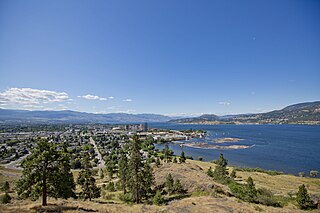
Kelowna is a city on Okanagan Lake in the Okanagan Valley in the southern interior of British Columbia, Canada. It serves as the head office of the Regional District of Central Okanagan. The name Kelowna derives from the Okanagan word kiʔláwnaʔ, referring to a grizzly bear.

William Richards Bennett, was the 27th premier of British Columbia from 1975 to 1986. He was a son of Annie Elizabeth May (Richards) and former premier W. A. C. Bennett.

Okanagan Lake is a lake in the Okanagan Valley of British Columbia, Canada. The lake is 135 km (84 mi) long, between 4 and 5 km wide, and has a surface area of 348 km2.

The Okanagan, also called the Okanagan Valley and sometimes the Okanagan Country, is a region in the Canadian province of British Columbia defined by the basin of Okanagan Lake and the Canadian portion of the Okanagan River. It is part of the Okanagan Country, extending into the United States as Okanogan County in north-central Washington. According to the 2016 Canadian census, the region's population is 362,258. The largest populated cities are Kelowna, Penticton, Vernon, and West Kelowna.
Highway 97 is a major highway in the Canadian province of British Columbia. It is the longest continuously numbered route in the province, running 2,081 km (1,293 mi) and is the only route that runs the entire north–south length of British Columbia, connecting the Canada–United States border near Osoyoos in the south to the British Columbia–Yukon boundary in the north at Watson Lake, Yukon.

The Regional District of Central Okanagan (RDCO) is a regional district in the Canadian province of British Columbia, representing two unincorporated Electoral Areas of Central Okanagan East and Central Okanagan West, along with the member municipalities of the City of Kelowna, City of West Kelowna, the District of Lake Country, the District of Peachland, and Westbank First Nation. The RDCO office is located in Kelowna.
Okanagan-Westside was a provincial electoral district for the Legislative Assembly of British Columbia, Canada from 2001 to 2009.
The Okanagan Lake Bridge was a three-lane, 650-metre (2,133-foot) long floating bridge in British Columbia, Canada. It crossed Okanagan Lake, connecting the Westside area to Kelowna on the lake's eastern side. Taller boats such as sailboats were able to pass under the lift span which was located at the east end of the bridge.

Mount Boucherie is a mountain located in West Kelowna on the west shore of Okanagan Lake, British Columbia, Canada, opposite the city of Kelowna. It is the remnants of a former stratovolcano created nearly 60 million years ago. Between four and six different glacial periods over the past 50 million years have eroded the volcano to produce Mount Boucherie. Though it now only rises 417 metres above the nearby lake level, it is estimated to once have had an elevation of 2,000 m (6,562 ft) or more.
The University of British Columbia Okanagan is a campus of the University of British Columbia in Kelowna, British Columbia, Canada.

West Kelowna, formerly known as Westside and colloquially known as Westbank, is a city in British Columbia's Okanagan Valley on the west shore of Okanagan Lake. The city encompasses several neighbourhoods, including Casa Loma, Gellatly, Glenrosa, Lakeview Heights, Shannon Lake, Smith Creek, Rose Valley, Westbank, and West Kelowna Estates. As of 2021, West Kelowna had an estimated population of 36,078.

Kelowna West or Westside-Kelowna is a former provincial electoral district in British Columbia, Canada. It combined a portion of the City of Kelowna on the east shore of Lake Okanagan with communities on the west shore.
The Coast Meridian Overpass is a four-lane cable stayed bridge in Port Coquitlam, British Columbia, crossing the Canadian Pacific railyard. It is 25 metres wide and 580 m long, with a bike lane on the northbound side and a separated pedestrian walkway on the southbound side of the overpass. The construction project, officially launched in 2008, links Coast Meridian Road and Lougheed Highway on the north with Kingsway Avenue and Broadway Street on the south. The speed limit on the bridge is 50 km/h.

Benjamin Richard Stewart is a Canadian politician, who has represented the riding of Kelowna West in the Legislative Assembly of British Columbia from 2018 until as a member of BC United. He previously represented the riding of Westside-Kelowna from 2009 to 2013.

Floats are airtight hollow structures, similar to pressure vessels, designed to provide buoyancy in water. Their principal applications are in watercraft hulls, aircraft floats, floating piers, pontoon rhinos, pontoon bridges, and marine engineering applications such as salvage.

Mission Creek is a large creek in the Okanagan Region of British Columbia. Originally called N'wha-kwi-sen, it was later mapped as Rivière de l’Anse-au-Sable, the name Mission Creek was adopted in 1860 in honour of the Catholic Oblate Mission established by Father Pandosy and other settlers. The Creek rises in the Greystoke Mountain Range and runs west about 43 kilometres (27 mi) before emptying into Okanagan Lake south of Kelowna. Its watershed covers about 200,000 square kilometres . Mission Creek was designated a BC Heritage River by the province in 1996.
97 Express Kelowna RapidBus or 97 Okanagan is a bus rapid transit line operated by Kelowna Regional Transit System since September 2010 in Central Okanagan, British Columbia, Canada. The service connects UBC Okanagan Exchange, Downtown Kelowna and Westbank Centre. 97X RapidBus offers high speed bus service by utilizing traffic signal priority and HOV lanes on Highway 97.
The Okanagan Regional Library (ORL) system serves the Okanagan region of the Canadian province of British Columbia. Its administrative headquarters are in Kelowna. The system covers 59,000 square kilometers of area, and serves 360,000 people through 30 branches. ORL was founded in 1936. In 2013, the library held 3.2 million physical items. The library is largely funded through tax revenues from four administrative areas, the Regional District of North Okanagan, the Regional District of Central Okanagan, the Columbia-Shuswap Regional District, and the Regional District of Okanagan Similkameen. It also receives funding from the provincial and federal governments.
AtkinsRéalis Group Inc., previously known as SNC-Lavalin Group Inc., is a Canadian company based in Montreal that provides engineering, procurement, and construction (EPC) services to various industries, including mining and metallurgy, environment and water, infrastructure, and clean energy. AtkinsRéalis was the largest construction company, by revenue, in Canada, as of 2021.

















